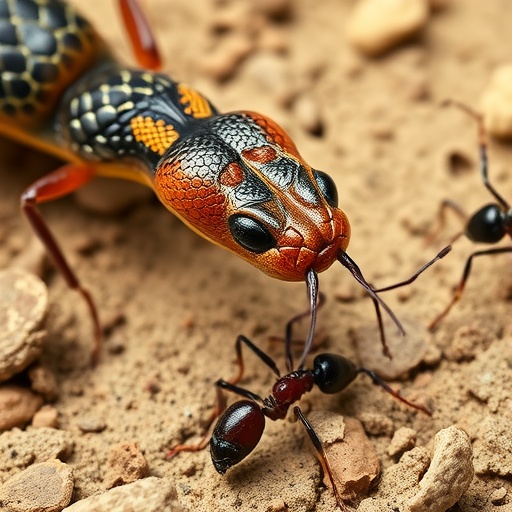In a groundbreaking study published in Scientific Naturalists, researchers have unveiled the intriguing relationship between snake scent gland secretions and their effects on ants. The research, led by Weldon and Vander Meer, delves into how these secretions serve as potent biochemical agents that not only repel ants but can also induce contact toxicity. This fascinating exploration of predator-prey interactions reveals the complex dynamics of chemical communication in the animal kingdom, providing a deeper understanding of ecological networks.
The phenomenon investigated in this study highlights the evolutionary arms race between predators and their prey. Ants, known for their aggressive foraging strategies and complex social structures, seem particularly affected by the biochemical arsenal displayed by certain snake species. As these snakes secrete substances from their scent glands, they introduce a whole new dimension to the interactions within ecosystems, demonstrating that chemical signals can play a significant role in survival strategies.
During the research, Weldon and Vander Meer meticulously collected samples of snake gland secretions and subsequently exposed various ant species to these substances. The response was striking; many ants exhibited immediate aversion, retreating from the source of the scent. This behavior suggests that the chemical composition of the secretions contains cues that ants have evolved to recognize as threats, thereby ensuring their survival.
Further analysis of the secretions revealed that they contain a range of bioactive compounds. These include various proteins and pheromones that not only act as repellents but also compromise the physiological integrity of the ants upon contact. The implications of these findings are profound, as they suggest that the evolution of snake defensive mechanisms has inevitably shaped ant behavior and physiology, leading to an intricate dance of survival tactics.
Moreover, the study sheds light on the broader ecological implications of this interaction. In ecosystems where both snakes and ants coexist, the selective pressures exerted by these toxic secretions may lead to co-evolutionary dynamics, where ants develop strategies to mitigate the effects of these chemicals. This interspecific competition underscores the importance of chemical ecology in evolutionary biology, highlighting how species adapt not just to their environments but to the behaviors and defenses of one another.
In the face of climate change and habitat disruption, understanding these interactions becomes increasingly critical. The insights gained from this research could assist in the broader conservation efforts, aiding in the preservation of these species and their habitats. As more species are pushed to the brink due to environmental stressors, deciphering the intricate biochemical languages of snakes and ants could equip ecologists and conservationists with the knowledge needed to preserve these vital ecosystems.
Furthermore, the findings prompt a reevaluation of how we perceive the roles of snakes in their ecosystems. Often vilified and misunderstood, these reptiles are keystone species, playing crucial roles in controlling populations of their prey, including various insect species. Recognizing the complexities of their interactions with other animals, like ants, enhances our comprehension of biodiversity and ecosystem health.
As the study continues to garner attention, the implications of this research extend beyond academic circles. It sparks public interest in the often-overlooked but vital chemical relationships that govern wildlife behavior. By illuminating such biological phenomena, the research fosters a deeper appreciation for the intricate web of life that surrounds us.
In terms of further research, the work of Weldon and Vander Meer opens several avenues for exploration. Future studies could investigate the specific compounds responsible for the repellent and toxic effects on a broader range of ant species. Additionally, understanding the hormonal and neurological pathways that control ant behavior in response to these chemicals may yield fascinating insights into insect behavior and ecology.
In conclusion, the revelation that snake gland secretions can repel ants and induce toxicity not only advances our understanding of interspecies interactions but also challenges us to rethink our approach to conservation and biodiversity. It reminds us that the natural world is a complex tapestry of relationships, each thread woven together by the shared language of chemistry, behavior, and evolution, ultimately showcasing the beauty and intricacy of life on Earth.
As scientists continue to explore these dynamics, it is paramount that we heed their findings. Only through understanding the delicate balance of these chemical interactions can we hope to protect the very ecosystems that sustain us. This research stands as a testament to the power of scientific inquiry, offering a glimpse into the unseen battles fought and won in the natural world, urging us to remain vigilant stewards of our environment.
Subject of Research: The effects of snake scent gland secretions on ant behavior and physiology.
Article Title: Snake scent gland secretions repel and induce contact toxicity in ants.
Article References:
Weldon, P.J., Vander Meer, R.K. Snake scent gland secretions repel and induce contact toxicity in ants. Sci Nat 112, 41 (2025). https://doi.org/10.1007/s00114-025-01990-4
Image Credits: AI Generated
DOI: https://doi.org/10.1007/s00114-025-01990-4
Keywords: Snake, Ant, Chemical Ecology, Toxins, Evolutionary Biology, Biodiversity, Ecosystems, Co-evolution.
Tags: ant behavior and responsesant repellent chemicalsbiochemical agents in ecologychemical communication in animalscomplex social structures of antsecological networks and dynamicsevolutionary arms race in naturegroundbreaking research in animal behaviorpredator-prey interactionssnake scent gland secretionssurvival strategies in ecosystemstoxicity effects of snake secretions





